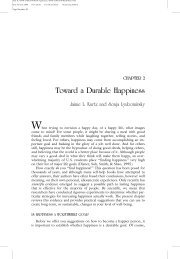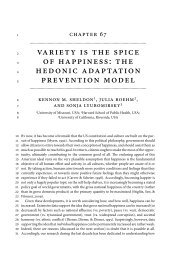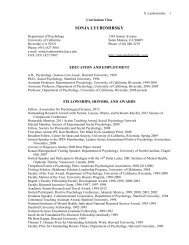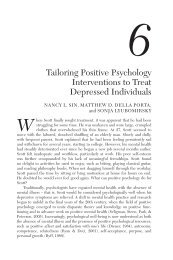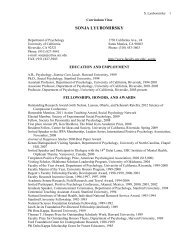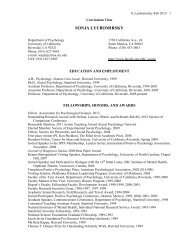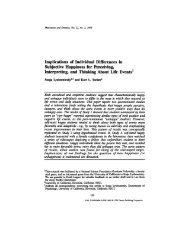How Do Simple Positive Activities Increase Well-Being? - Sonja ...
How Do Simple Positive Activities Increase Well-Being? - Sonja ...
How Do Simple Positive Activities Increase Well-Being? - Sonja ...
You also want an ePaper? Increase the reach of your titles
YUMPU automatically turns print PDFs into web optimized ePapers that Google loves.
<strong>How</strong> <strong>Do</strong> <strong>Simple</strong> <strong>Positive</strong> <strong>Activities</strong> <strong>Increase</strong><strong>Well</strong>-<strong>Being</strong>?Current Directions in PsychologicalScienceXX(X) 1 –6© The Author(s) 2013Reprints and permission:sagepub.com/journalsPermissions.navDOI: 10.1177/0963721412469809http://cdps.sagepub.com<strong>Sonja</strong> Lyubomirsky and Kristin LayousUniversity of California, RiversideAbstractTheory and research suggest that people can increase their happiness through simple intentional positive activities, such asexpressing gratitude or practicing kindness. [AQ: 1]Investigators have recently begun to study the optimal conditions underwhich positive activities increase happiness and the mechanisms by which these effects work. According to our positiveactivitymodel, features of positive activities (e.g., their dosage and variety), features of persons (e.g., their motivation andeffort), and person–activity fit moderate the effect of positive activities on well-being. Furthermore, the model positsfour mediating variables: positive emotions, positive thoughts, positive behaviors, and need satisfaction. Empirical evidencesupporting the model and future directions are discussed.Keywordshappiness, subjective well-being, positive activities, positive interventions, self-improvementHappiness not only feels good, it is good. Happier people havemore stable marriages, stronger immune systems, higherincomes, and more creative ideas than their less happy peers(Lyubomirsky, King, & Diener, 2005). Furthermore, crosssectional,longitudinal, and experimental studies have demonstratedthat happiness (i.e., long-term positive affect orwell-being) is not merely a correlate or consequence of successbut a cause of it (Lyubomirsky, King, & Diener, 2005).For the majority of people around the globe who report wantingto be happy (Diener, 2000), these findings would be dishearteningif happiness could not be achieved intentionally.Despite evidence suggesting that individual differences inwell-being are strongly influenced by genetics (e.g., Lykken &Tellegen, 1996), researchers have theorized that much of people’shappiness is under their control (Lyubomirsky, Sheldon,& Schkade, 2005). A study that combined results from 51 randomizedcontrolled interventions found that people promptedto engage in positive intentional activities, such as thinkinggratefully, optimistically, or mindfully, became significantlyhappier (Sin & Lyubomirsky, 2009).By examining the characteristics of dispositionally happypeople (e.g., their tendencies to be grateful, exhibit optimisticthinking, and engage in prosocial behavior; Lyubomirsky,2001), researchers have been able to posit activities thatmight increase people’s happiness if deliberately practiced.We define positive activities as simple, intentional, and regularpractices meant to mimic the myriad healthy thoughts andbehaviors associated with naturally happy people. The efficacyof numerous positive activities for improving well-beinghas now been tested empirically. Experimenters haveprompted people to write letters expressing gratitude (Boehm,Lyubomirsky, & Sheldon, 2011; Lyubomirsky, Dickerhoof,Boehm, & Sheldon, 2011; Seligman, Steen, Park, & Peterson,2005), to count their blessings (Emmons & McCullough,2003; Lyubomirsky, Sheldon, et al., 2005; Seligman et al.,2005), to perform kind acts (Della Porta, Jacobs Bao, &Lyubomirsky, 2012; Lyubomirsky, Sheldon, & Schkade, 2005;Sheldon, Boehm, & Lyubomirsky, 2012), to cultivate theirstrengths (Seligman et al., 2005), to visualize their ideal futureselves (Boehm et al., 2011; King, 2001; Layous, Nelson, &Lyubomirsky, 2012), and to meditate (Fredrickson, Cohn,Coffey, Pek, & Finkel, 2008). All of these practices are brief,self-administered, and cost-effective.Factors Affecting the Success of <strong>Positive</strong><strong>Activities</strong>Research on happiness-increasing strategies has shown thatthey work (Sin & Lyubomirsky, 2009), but under what conditionsdo they work best? Our positive-activity model (seeFig. 1) draws on theoretical and empirical evidence to depict(a) an overview of the activity features and person featuresthat render a positive activity optimally effective and (b) theCorresponding Author:<strong>Sonja</strong> Lyubomirsky, Department of Psychology, University of California,Riverside, CA 92521E-mail: sonja.lyubomirsky@ucr.edu
2 Lyubomirsky, LayousFig. 1. The positive-activity model, which aims to explain how and why performing positive activities makes people happier. Asillustrated at top, positive activities increase positive emotions, positive thoughts, positive behaviors, and need satisfaction, all ofwhich in turn enhance well-being. Features of positive activities (e.g., dosage and variety) and of the person (e.g., motivation andeffort) influence the degree to which the activities improve well-being. An optimal person–activity fit (i.e., the overlap betweenactivity and person features) further predicts increases in well-being.mechanisms that underlie the positive activity’s successfulimprovement of well-being. Furthermore, the extent to whichany activity feature influences a positive activity’s successdepends on the fit between the person (e.g., his or her personalityor culture) and that activity feature (e.g., dosage or socialsupport; represented in Fig. 1 as person-activity fit).ModeratorsUsing randomized controlled studies, researchers have identifiedseveral conditions under which positive activities mosteffectively enhance happiness. Activity features concern thepositive activity itself (e.g., what type of behavior it is and howoften it is practiced), whereas person features pertain to the personpracticing the positive activity (e.g., whether he or she ismotivated to pursue happiness). Finally, person–activity fit isthe customized match between activity and person features.Features of the activity. [AQ: 2]Features of positiveactivities—including their dosage, variety, and sequence andthe social support built into them—all influence their successat increasing happiness. For example, as with any medicalor psychological treatment, the dosage (i.e., frequency andtiming) of a positive activity matters. In one study, performingfive kind acts in one day each week (for 6 weeks) resulted inlarger increases in well-being than did performing five kindacts throughout the week (Lyubomirsky, Sheldon, & Schkade,2005), a pattern indicating that “watering down” positiveactivities by spreading them out might limit their potency.Other positive activities, however, could easily be overdone.For example, in another study, counting one’s blessingswas less effective three times per week than once per week(Lyubomirsky, Sheldon, & Schkade, 2005). What is interestingis that both studies suggested that positive activities performedonce a week are maximally effective, possibly because
<strong>Positive</strong>-Activity Model 3many cultural routines (involving work, worship, and eventelevision) are conducted weekly.Determining the ideal dosage of positive activities is tricky,however, because it likely varies by person and by activity. Forexample, in naturalistic settings, people report practicinghappiness-increasing activities several times a week for morethan an hour each time (Parks, Della Porta, Pierce, Zilca, &Lyubomirsky, 2012), and in one study, users of a positiveactivitysmartphone application reported bigger benefits whenthey logged in more frequently (Parks et al., 2012, Study 3).Perhaps when people are free to choose their happinessincreasingactivities, they do not view the activities as cumbersomeand gladly perform them for longer and more often.Hence, person–activity fit likely governs optimal dosage.Furthermore, when people choose their own positive activitiesrather than following an experimenter’s instructions, theymay be more likely to vary their practices. Theory and researchsuggest that positive changes in people’s lives (e.g., beginningan exercise regimen; Glaros & Janelle, 2001) are more likelyto promote sustained boosts in well-being if the events generatedby the positive changes are varied (for a review, seeLyubomirsky, 2011). For example, participants who performedvaried kind acts every week increased their levels of wellbeingmore than did participants who performed the same kindacts (Sheldon et al., 2012).Variety matters not only to the practice of a single positiveactivity but also to the practice of multiple activities. Indeed,participants in the naturalistic study reported performingalmost eight different positive activities simultaneously (Parkset al., 2012), and participants in a Web-based study obtainedthe biggest benefits when practicing two or four positive activitiesconcurrently (Schueller & Parks, 2012). Further evidencehas suggested that certain positive activities might be good“starter” activities. U.S. participants who began a 6-week happinessintervention by writing letters expressing gratitudeexperienced greater increases in well-being than did thosewho began by performing acts of kindness (Layous, Lee, Choi,& Lyubomirsky, 2012). Expressing gratitude might haveserved as a trigger that precipitated an immediate upward spiralof positive emotions (Fredrickson, 2001) or galvanizedpeople to “pay it forward,” thereby leading them to exert moreeffort and ultimately reap greater benefits.Engaging in positive activities, like making other behavioralchanges, is also more successful when the doers of positiveactivities have social support (Bandura, 1986). Forexample, participants who received autonomy-supportingmessages from a peer while performing kind acts saw largerimprovements in happiness than those who did not receivesocial support or who performed a control activity (Della Portaet al., 2012). Similarly, students who read an empathetic peertestimonial about the challenges of an optimism-boostingexercise experienced greater increases in positive affect thanall other groups (Layous, Nelson, & Lyubomirsky, 2012). Theresults from these two studies indicate that even virtual socialsupport[AQ: 3] can bolster the benefits of positive activities.Factors like variety and social support can conceivably beapplied to any positive activity (see the list of variables underthe “Across” heading in the “Activity Features” box in Fig. 1).Other factors, however, differentiate positive activities fromone another (see the list of variables under the “Between”heading in the “Activity Features” box in Fig. 1) and hencemay cause certain activities to work best for certain people.For example, positive activities can be relatively self-oriented(e.g., practicing optimism) or other-oriented (e.g., expressinggratitude). Collectivists might benefit more from otherorientedpositive activities and individualists from selforientedactivities (for suggestive evidence, see Boehm et al.,2011). Further, certain positive activities are social–behavioralin nature (e.g., being kind), whereas others are reflective–cognitive (e.g., savoring happy times), potentially benefittingparticularly lonely and frazzled individuals, respectively.Finally, positive activities differ in their time orientation—theymay be focused on the past (e.g., expressing gratitude), thepresent (e.g., savoring the moment), or the future (e.g., thinkingoptimistically; Sin & Lyubomirsky, 2009). Older adults mightbenefit more from reflecting on their legacies, whereas youthsmight benefit more from visualizing bright futures.Features of the person. Overall, positive activities that haveoptimal features are more likely to promote durable wellbeing.<strong>How</strong>ever, attributes of the person engaging in the activityalso matter. As illustrated in Figure 1 (see the “PersonFeatures” box), for people to benefit from a positive activity(or any self-improvement behavior, for that matter), they haveto effortfully engage in it (Layous, Lee, et al., 2012; Lyubomirskyet al., 2011), be motivated to become happier (Deci& Ryan, 2000; Lyubomirsky et al., 2011), and believe thattheir efforts will pay off (Ajzen, 1991; Bandura, 1986; Layous,Nelson, & Lyubomirsky, 2012). For example, participantswho deliberately chose to complete “happiness-increasing”exercises (rather than neutral ones) and who put more effortinto them (as assessed by judges) showed bigger gains in wellbeing(Lyubomirsky et al., 2011).In addition to people’s motivation, efforts, and beliefs, people’spersonalities may affect how much they stand to gainfrom positive activities. Although the association between personalityand happiness is long established (Costa & McCrae,1980), researchers are only now exploring whether individuals’personalities influence positive activities’ success. Recentevidence has shown that people who are highly extravertedand open to experience are especially predisposed to benefitfrom positive activities (Senf & Liau, 2012).People’s initial affective state when they embark on a positiveactivity also predicts how much they will benefit from it,but the evidence in this area is mixed. Some research has suggestedthat people low in positive affect (Froh, Kashdan, Ozimkowski,& Miller, 2009) or with moderate depressive symptoms(Seligman et al., 2005) benefit the most from positive activities,perhaps because they have more room to improve. Other evidencehas indicated that moderately depressed individuals have
4 Lyubomirsky, Layousdeficits that prevent them from taking full advantage of somepositive practices—such individuals, for example, benefit morefrom simple pleasant activities than from reflective ones (Sin,Della Porta, & Lyubomirsky, 2011). More research is needed toidentify specific activities that are optimal for individuals withinspecific affective ranges.The degree to which people perceive support from theirown social network—especially support for their pursuit ofhappiness—is also likely to affect their ability to reap rewardsfrom positive activities. We predict that happiness seekerswho feel more supported by close others in their positive practiceswill see relatively greater improvements in well-being(see Wing & Jeffery, 1999, for parallel findings regardingweight loss).Finally, demographic variables may influence gains inwell-being from positive activities. For example, older peoplebenefit relatively more than younger people from practicing arange of positive activities (Sin & Lyubomirsky, 2009), perhapsbecause they have more time to commit to the activities,take them more seriously, and engage in them more effortfully.Also, Westerners gain more from positive activities (namely,expressing gratitude and optimism) than Easterners do (Boehmet al., 2011), possibly because Westerners value and expresshappiness more (Diener, Suh, Smith, & Shao, 1995; Tsai,Knutson, & Fung, 2006). Further research should examine therole of other demographic factors, such as sex and socioeconomicstatus. For example, people struggling to afford foodare likely to regard the pursuit of happiness as frivolous.Person–activity fit. Although features of positive activitiesand features of the doers of positive activities broadly influencethose activities’ success at increasing happiness, certaintypes of activities are better for certain types of people. Wepredict that activity features and person features interact withone another (note the overlap of the “Activity Features” and“Person Features” boxes in Fig. 1). This notion of the importanceof person–activity fit is supported by studies showingthat the degree to which participants report enjoying apositive activity predicts how often they complete that activity(Schueller, 2010) and how much happiness they derive from it(Lyubomirsky, 2008).MechanismsAlthough research has begun to reveal the conditions underwhich positive activities increase well-being, investigatorsstill know little about how positive activities work and aboutthe processes by which they boost well-being. We positthat positive activities are positive for an individual only tothe extent that they stimulate increases in positive emotions,positive thoughts, positive behaviors, and need satisfaction,which in turn increase happiness. For example, increases inpositive emotions triggered by a meditation-based positiveactivity mediated the relationship between the activity andsubsequent improvements in such personal resources as socialrelationships and physical health. These enhanced personalresources then boosted life satisfaction (Fredrickson et al.,2008). Engaging in positive activities also leads people to construelife events more positively. In one study, people whoexpressed gratitude and optimism reported their weekly experiencesas being more satisfying over time, although ratings byindependent raters did not demonstrate any objective improvementin the experiences (Dickerhoof, 2007). Further, positiveactivities can prompt people to engage in unrelated positivebehaviors. For example, participants instructed to “count theirblessings” increased their time spent exercising (Emmons &McCullough, 2003).Practicing positive activities may also boost well-being bysatisfying basic psychological needs, such as autonomy (control),relatedness (connectedness), and competence (efficacy;Deci & Ryan, 2000). In a 6-week intervention, expressinggratitude and optimism increased self-reported autonomy andrelatedness (but not competence), which in turn increased lifesatisfaction (Boehm, Lyubomirsky, & Sheldon, 2012). In astudy that directly manipulated these hypothesized mediators,people who engaged in autonomy- and relatedness-fulfillingactivities saw greater increases in well-being than did peoplewho focused on their life circumstances (Sheldon et al., 2010).More research is needed to determine the mediating role ofcompetence and to investigate whether particular positiveactivities might be better suited to fulfilling particular needs.Future Directions and ConclusionsHappiness seekers no longer need rely on unsubstantiatedadvice from self-help books, magazine sidebars, or infomercials.Instead, a growing body of evidence based on randomizedcontrolled experiments demonstrates that relativelysimple intentional changes in one’s thoughts and behaviorscan precipitate meaningful increases in happiness. Furthermore,as highlighted by the positive-activity model, investigatorshave begun to pinpoint (albeit likely nonexhaustively) theconditions under which positive activities are most efficaciousand the processes by which they work. The model also revealsgaps in empirical evidence (e.g., regarding the role of socialsupport) and conflicting findings (e.g., regarding the role ofone’s initial affective state) that await further research.The positive-activity model addresses activity features andperson features that influence the success of positive activitiesas people perform them. <strong>How</strong>ever, future research should alsoinvestigate how people select positive activities in the firstplace. For example, individuals high in sensation seekingmight choose varied and novel (rather than similar and familiar)positive activities, and mildly depressed individuals mightchoose relatively undemanding activities.Our model could also be extended to predict the extent towhich doers of positive activities persist at them—and hencecontinue to reap benefits (Cohn & Fredrickson, 2010; Lyubomirskyet al., 2011; Seligman et al., 2005). One of the obstaclesto both continued engagement and continued benefits is
<strong>Positive</strong>-Activity Model 5hedonic adaptation; in other words, the rewards of positiveactivities dissipate with time (Lyubomirsky, 2011; Sheldonet al., 2012). To avoid adaptation, happiness seekers shouldvary their positive practices (which activities to perform, howmany, how often, and with whom). Additionally, the moremotivated individuals are to pursue happiness (Lyubomirskyet al., 2011), the more their families or cultures endorse thispursuit, and the more resources (e.g., time, effort) they have toaccomplish it, the more likely they are to maintain their efforts(but see Gruber, Mauss, & Tamir, 2011).In sum, as researchers begin to understand the how, what,when, and why of happiness-increasing strategies, they willbecome better positioned to provide empirically based adviceto the millions of people—in family, school, work, health,organizational, or mental health settings—who yearn to behappier.Recommended ReadingGruber, J., Mauss, I. B., & Tamir, M. (2011). (See References). Adiscussion of four conditions under which the pursuit of happinessis detrimental.Layous, K., & Lyubomirsky, S. (in press). The how, who, what,when, and why of happiness: Mechanisms underlying the successof positive interventions. In J. Gruber & J. Moskowitz (Eds.),Light and dark side of positive emotion. Oxford, England: OxfordUniversity Press. A chapter providing a detailed discussion ofthe moderators and mediators proposed by the positive-activitymodel.Lyubomirsky, S. (2008). (See References). A highly accessible,empirically driven overview of happiness-increasing strategies.Seligman, M. E. P., Steen, T. A., Park, N., & Peterson, C. (2005). (SeeReferences). A study illustrating original research on the benefitsof multiple representative positive activities.Sheldon, K. M., Kashdan, T. B., & Steger, M. F. (Eds.). (2011).Designing positive psychology: Taking stock and moving forward.New York, NY: Oxford University Press. An edited volume withchapters highlighting cutting-edge research related to positiveactivities and well-being.Declaration of Conflicting InterestsThe authors declared that they had no conflicts of interest withrespect to their authorship or the publication of this article.ReferencesAjzen, I. (1991). The theory of planned behavior. OrganizationalBehavior and Human Processes, 50, 179–211.Bandura, A. (1986). Social foundations of thought and action: Asocial cognitive theory. Englewood Cliffs, NJ: Prentice Hall.Boehm, J. K., Lyubomirsky, S., & Sheldon, K. M. (2011). Alongitudinal experimental study comparing the effectiveness ofhappiness-enhancing strategies in Anglo Americans and AsianAmericans. Cognition & Emotion, 25, 1263–1272.Boehm, J. K., Lyubomirsky, S., & Sheldon, K. M. (2012). [The roleof need satisfying emotions in a positive activity intervention].Unpublished raw data.Cohn, M. A., & Fredrickson, B. L. (2010). In search of durable positivepsychology interventions: Predictors and consequences oflong-term positive behavior change. Journal of <strong>Positive</strong> Psychology,5, 355–366.Costa, P. T., & McCrae, R. R. (1980). Influence of extraversionand neuroticism on subjective well-being: Happy and unhappypeople. Journal of Personality and Social Psychology, 38,668–678.Deci, E. L., & Ryan, R. M. (2000). Self-determination theory and thefacilitation of intrinsic motivation, social development, and wellbeing.American Psychologist, 55, 68–78.Della Porta, M. D., Jacobs Bao, K., & Lyubomirsky, S. (2012). <strong>Do</strong>essupporting autonomy facilitate the pursuit of happiness? Resultsfrom an experimental longitudinal well-being intervention.Manuscript submitted for publication.Dickerhoof, R. M. (2007). Expressing optimism and gratitude: A longitudinalinvestigation of cognitive strategies to increase wellbeing.Dissertation Abstracts International, 68, 4174 (UMI No.3270426).Diener, E. (2000). Subjective well-being: The science of happinessand a proposal for a national index. American Psychologist, 55,34–43.Diener, E., Suh, E. M., Smith, H., & Shao, L. (1995). National differencesin subjective well-being: Why do they occur? Social IndicatorsResearch, 34, 7–32.Emmons, R. A., & McCullough, M. E. (2003). Counting blessingsversus burdens: An experimental investigation of gratitude andsubjective well-being in daily life. Journal of Personality andSocial Psychology, 84, 377–389.Fredrickson, B. L. (2001). The role of positive emotions in positivepsychology: The broaden-and-build theory of positive emotions.American Psychologist, 56, 218–226.Fredrickson, B. L., Cohn, M. A., Coffey, K. A., Pek, J., & Finkel,S. M. (2008). Open hearts build lives: <strong>Positive</strong> emotions, inducedthrough loving-kindness meditation, build consequential personalresources. Journal of Personality and Social Psychology,95, 1045–1062.Froh, J. J., Kashdan, T. B., Ozimkowski, K. M., & Miller, N. M.(2009). Who benefits the most from a gratitude intervention inchildren and adolescents? Examining positive affect as a moderator.Journal of <strong>Positive</strong> Psychology, 4, 408–422.Glaros, N. M., & Janelle, C. M. (2001). Varying the mode of cardiovascularexercise to increase adherence. Journal of Sport Behavior,24, 42–62.Gruber, J., Mauss, I. B., & Tamir, M. (2011). A dark side of happiness?<strong>How</strong>, when, and why happiness is not always good. Perspectiveson Psychological Science, 6, 222–233.King, L. A. (2001). The health benefits of writing about life goals.Personality and Social Psychology Bulletin, 27, 798–807.Layous, K., Lee, H. C., Choi, I., & Lyubomirsky, S. (2012). Culturematters when designing a successful positive activity: A comparisonof the United States and South Korea. Manuscript submittedfor publication.Layous, K., Nelson, S. K., & Lyubomirsky, S. (2012). What is theoptimal way to deliver a positive activity intervention? The case
6 Lyubomirsky, Layousof writing about one’s best possible selves. Journal of HappinessStudies. Advance online publication. doi:10.1007/s10902-012-9346-2Lykken, D., & Tellegen, A. (1996). Happiness is a stochastic phenomenon.Psychological Science, 7, 186–189.Lyubomirsky, S. (2001). Why are some people happier than others?American Psychologist, 56, 239–249.Lyubomirsky, S. (2008). The how of happiness: A scientific approachto getting the life you want. New York, NY: Penguin Press.Lyubomirsky, S. (2011). Hedonic adaptation to positive and negativeexperiences. In S. Folkman (Ed.), Oxford handbook of stress,health, and coping (pp. 200–224). New York, NY: Oxford UniversityPress.Lyubomirsky, S., Dickerhoof, R., Boehm, J. K., & Sheldon, K. M.(2011). Becoming happier takes both a will and a proper way:An experimental longitudinal intervention to boost well-being.Emotion, 11, 391–402.Lyubomirsky, S., King, L., & Diener, E. (2005). The benefits of frequentpositive affect: <strong>Do</strong>es happiness lead to success? PsychologicalBulletin, 131, 803–855.Lyubomirsky, S., Sheldon, K. M., & Schkade, D. (2005). Pursuinghappiness: The architecture of sustainable change. Review ofGeneral Psychology, 9, 111–131.Parks, A., Della Porta, M., Pierce, R. S., Zilca, R., & Lyubomirsky, S.(2012). Pursuing happiness in everyday life: The characteristicsand behaviors of online happiness seekers. Emotion. Advanceonline publication. doi:10.1037/a0028587Schueller, S. M. (2010). Preferences for positive psychology exercises.The Journal of <strong>Positive</strong> Psychology, 5, 192–203.Schueller, S. M., & Parks, A. (2012). Disseminating self-help: <strong>Positive</strong>psychology exercises in an online trial. Journal of MedicalInternet Research, 14, e63.Seligman, M. E. P., Steen, T. A., Park, N., & Peterson, C. (2005).<strong>Positive</strong> psychology progress: Empirical validation of interventions.American Psychologist, 60, 410–421.Senf, K., & Liau, A. K. (2012). The effects of positive interventionson happiness and depressive symptoms, with an examinationof personality as a moderator. Journal of Happiness Studies.Advance online publication. doi:10.1007/s10902-012-9344-4Sheldon, K. M., Abad, N., Ferguson, Y., Gunz, A., Houser-Marko, L.,Nichols, C. P., & Lyubomirsky, S. (2010). Persistent pursuit of needsatisfying goals leads to increased happiness: A 6-month experimentallongitudinal study. Motivation and Emotion, 34, 39–48.Sheldon, K. M., Boehm, J. K., & Lyubomirsky, S. (2012). Variety isthe spice of happiness: The hedonic adaptation prevention (HAP)model. In I. Boniwell & S. David (Eds.), Oxford handbook ofhappiness (pp. 901–914). Oxford, England: Oxford UniversityPress.Sin, N. L., Della Porta, M. D., & Lyubomirsky, S. (2011). Tailoringpositive psychology interventions to treat depressed individuals.In S. I. <strong>Do</strong>naldson, M. Csikszentmihalyi, & J. Nakamura (Eds.),Applied positive psychology: Improving everyday life, health,schools, work, and society (pp. 79–96). New York, NY: Routledge.Sin, N. L., & Lyubomirsky, S. (2009). Enhancing well-being andalleviating depressive symptoms with positive psychology interventions:A practice friendly meta-analysis. Journal of ClinicalPsychology, 65, 467–487.Tsai, J. L., Knutson, B., & Fung, H. H. (2006). Cultural variation inaffect valuation. Journal of Personality and Social Psychology,90, 288–307.Wing, R. R., & Jeffery, R. W. (1999). Benefits of recruiting participantswith friends and increasing social support for weight lossand maintenance. Journal of Consulting and Clinical Psychology,67, 132–138.



